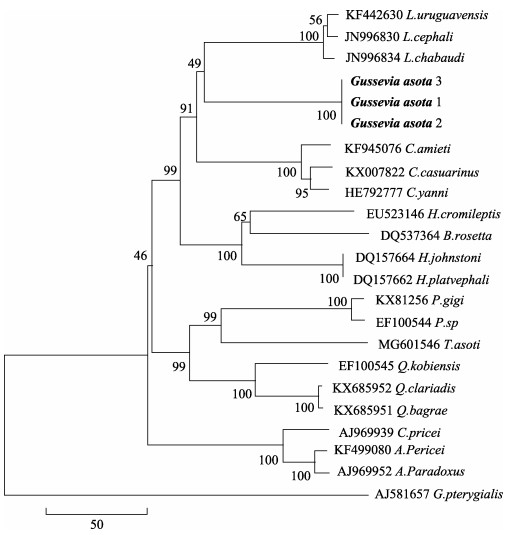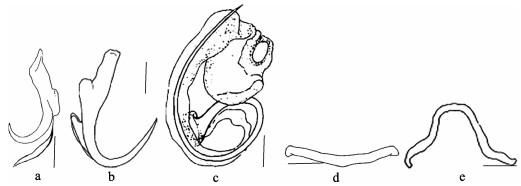图丽鱼(Astronotus ocellatus)别名“地图鱼”、“猪仔鱼”等,是一种原产于秘鲁、哥伦比亚和巴西亚马逊流域和法属圭亚那、阿根廷一带的热带淡水、底栖性鱼类(鲈形目Perciformes、慈鲷科Cichlidae);作为一个引进的物种也存在于巴西流域盆地(De Azevedo et al, 2007)。对水族爱好者来说,它是一种非常受欢迎的商业性慈鲷科鱼类,同时,也因其鲜美的肉质而被亚马逊流域的人作为一种食用鱼(Delgado et al, 2014; Tavares-Dias et al, 2014)。近年来,随着“一带一路”经济带的建设,新疆地区的水产养殖发展迅速,但在发展的过程中,也出现一些疾病问题,如寄生虫就是严重危害当地养殖鱼类的重要病原之一。
古氏虫属(Gussevia)(Kohn et al, 1964)隶属于锚首虫亚科(Ancyrocephalinae),其中,包括17种有效物种,这些单殖吸虫通常寄生于慈鲷科鱼类的鳃部(Thatcher, 1991)。Ľubomír Šmiga等(2016)研究发现,当大量的虫体寄生于鱼体时,鱼表现出明显的窒息,神经系统症状(狂游、碰壁等),运动失调和突然死亡。长期以来,单殖吸虫的鉴定主要是依靠其具有鉴定意义的几丁质结构的形态进行,但是,由于单殖吸虫种类繁多,且形态极为相近,这就为虫种的正确鉴定带来一定的困难。近年来,随着分子标记技术的迅速发展,基因组序列测定已逐步成为物种分子系统发育学研究的普遍方法,尤其是核糖体基因,在寄生虫物种鉴定、亲缘关系的演化等方面尤为突出(孟飞燕, 2016; Mollaret et al, 2000; 丁雪娟等, 2005)。本研究通过测定破坏古氏虫的28S rDNA的序列,旨在为该虫在分子系统进化方面提供基础资料,同时,也填补了该虫在分子生物学研究方面的空白。
1 材料与方法 1.1 样品的来源2016年5月~2017年6月,对新疆乌鲁木齐明珠花卉市场和华凌观赏鱼市场养殖观赏鱼做寄生虫学调查期间,先后采集到图丽鱼18尾。将活鱼运送到实验室并进行拍照、测量和称重,并使用常规解剖法将鱼处死后,对其进行寄生虫学检查,分别剪取每条鱼的鳃片,在解剖镜下逐一检查,发现寄生虫后,用吸管吸取到1.5 ml的EP管中,滴加不同浓度的乙醇保存。
1.2 形态学鉴定在解剖镜下挑取形态完整的虫体放置在载玻片上,用4%聚乙烯乳酸酚(伍惠生, 1980)固定封片,并在光学显微镜下拍照,测定背腹中央大钩、联接片、交接器等几丁质结构,小括号前的数值为所测量标本的平均值,括号中为量度变化范围。所制虫体标本保存在新疆农业大学动物医学学院寄生虫实验室。
1.3 DNA提取及目的基因的PCR扩增依据形态学鉴定结果,选取95%乙醇保存的虫体若干只,清水冲洗,TE缓冲液浸泡过夜后,分别装入1.5 ml的EP管中,用DNA提取试剂盒提取虫体DNA,保存于-20℃冰箱中,用于后续实验。
分子标记选取核糖体DNA的28S rDNA序列,目的序列的扩增引物参照Hassouna等(1984),引物序列为MF1:5'-ATTCCGATAACGAACGAGACT-3',MR1:5'-GCTAGCTGCGTTCTTCATCGA-3'。PCR扩增的反应体系为50 μl,反应程序:95℃ 4 min;92℃ 1 min,55℃ 1 min,72℃ 1 min 30 s,35个循环;72℃10 min,4℃终止。
1.4 目的DNA序列的测定将扩增产物经1%的琼脂糖电泳分析,切取目的条带,用全式金胶回收试剂盒纯化后,送至生工生物工程(上海)股份有限公司进行测序。
1.5 基于28S rDNA序列的系统发育分析基于28S rDNA序列,以Gyrodactylus pterygialis为外类群,选取20种(表 1)已发表的分属于锚首虫亚科不同属之间的28S rDNA序列,与本研究所测得的序列一起,在MEGA 7.0软件中构建系统发育树。
|
|
表 1 本实验用到的已发表的锚首虫亚科28S rDNA序列信息 Tab.1 List of published Ancyrocephalinae28S rDNAsequences used in this study |

|
图 3 基于28S rDNA序列构建的图丽鱼寄生破坏古氏虫邻接法(NJ)系统发育树 Fig.3 Phylogenetic tree of A. ocellatus parasitic G. asota based on 28S rDNA sequences using Neighbour-Joining method |
在对图丽鱼进行寄生虫学检查时,除了检查鳃丝外,还检查了其他内部的脏器组织和体表皮肤,但并没有发现其他的病原体存在。而在鳃片的检查过程中发现,该寄生虫偏好寄生在鳃丝顶端末梢,且感染率和感染强度非常高,分别达到92%和1~224。
基于被测量的8个虫体玻片标本,虫体全长为441.6 (307.7~530.8) μm,纺锤形,头区狭窄。头腺非常发达,4对,分别在头区顶部两端。眼点2对,等距,后一对较大。最大体宽为82.3 (50.8~96.4) μm。咽为卵圆形,直径为21.9 (19.8~25.1) μm。后吸器发育完全,分为发达的前叶和后叶,前叶大于后叶的腺体斑块,后吸器宽为64.3 (50.9~79.8) μm。腹中央大钩全长为20.5 (15.7~22.9) μm,钩基长为18.2 (12.2~ 20.8) μm,钩尖长为8.7 (8.0~10.3) μm,具有发达的几丁质丝,内外突分化不明显,内突长为5.7 (3.5~ 9.8) μm,外突长为3.4 (3.1~3.7) μm。背中央大钩全长为25.4 (24.4~26.8) μm,钩基长为21.4 (20.6~ 24.4) μm,钩尖长为15.9 (14.3~17.4) μm,内外突分化明显,内突长为10.2 (8.7~12.0) μm,外突长为4.6 (4.3~4.9) μm。腹联接片大小为1.9x27.4 [(1.2~2.6)x (21.5~30.9)] μm,细丝状,末端卷曲在腹中央大钩基部。背联接片大小为3.8x37.5 [(2.6~5.7)x(24.5~44.1)] μm,棒状,末端稍扩大。边缘小钩7对,第1~4对和第6、7对边缘小钩为雏形钩,长为10.7 μm (N=2),第5对边缘小钩长为12.2 μm (N=2)。交接器由交接管和支持器2部分组成,交接管卷曲,基部膨大,长为52.2 (47.9~56.4) μm。支持器与交接管基部相连,末端扇形片具有1个几丁质结构的环,长为29.8 (28.8~30.8) μm。阴道右旋,外部具有硬化的保护结构。虫体前端有散在的虫卵分布,大小为2.1x1.1 [(1.4~2.7)x(0.7~1.6)] μm。
根据玻片标本图,测量虫体各结构,通过与各国已报到破坏古氏虫的测量数值进行比对(表 2)发现,部分数值大于或者小于其他测量值。根据Kritsky等(1989b)和Abdallah等(2008)研究表明,寄生虫的鉴定是基于后吸器几丁质结构(背腹中央大钩、联接片和边缘小钩)的形状和交配器。本研究发现,虫体的交接器、后吸器的结构(图 1)与Kritsky等(1989b)(图 2)所描述的原始种虫体的形态结构略有差异。而中国广东地区发现分离的虫体后吸器分叶不明显,且头区较宽,虫体并不呈纺锤形,且腹中央大钩的基本形态与本研究和国外报道的有一定差异。
|
|
表 2 已报道图丽鱼寄生破坏古氏虫的形态比较(括号中为范围)μm) Tab.2 Reported morphological comparison of A. ocellatus parasitic G. asota(The brackets indicate the range)(μm) |

|
图 1 破坏古氏虫交接器和后固着器的形态 Fig.1 The morphological features of copulatory organ and haptor of G. asota a:破坏古氏虫前端;b:破坏古氏虫后端(后吸器);1:交接器;比例尺=50 μm a: Anterior region of G. asota; b: Posterior region of G. asota (Haptor); 1: Copulatory organ; Scale bar=50 μm |

|
图 2 原始描述中关于破坏古氏虫的部分几丁质结构 Fig.2 The sclerotized hard parts of G. asota in the original description (Kritsky, 1989b) a:腹中央大钩;b:背中央大钩;c:交接器;d:背联接片;e:腹联接片。比例尺=30 μm a: Ventral anchor; b: Dorsal anchor; c: Copulatory organ; d: Ventral bar; e: Dorsal bar. Scale bar=30 μm |
在本研究中,增加了腹、背中央锚钩的参数测量,这些参数特征在原始种中没有表现出来。通过比对发现,本研究虫体的体长与原始种和广东地区分离的虫体体长最为接近,而秘鲁发现的虫体体长最大。体宽、后吸器宽与原始种最为接近。对比腹、背中央大钩长发现,其测量值均小于已报到虫体。而背联接片的测量参数大于其他虫体。
2.2 28S rDNA基因序列分析根据形态学鉴定结果,测定虫体的28S rDNA基因序列。此外,经文献检索尚无学者对古氏虫属的虫体做分子生物学方面的研究分析。本研究首次测定了破坏古氏虫的28S rDNA片段,其目的条带为864 bp,G+C含量为48.4%。将已获得的序列在NCBI中BLAST比对分析发现,该序列与嗜丽鱼虫属(Cichlidogyrus)、鲻鱼虫属(Ligophorus)物种的同源性最高,达90%。将获得的序列上传至GenBank,获得GenBank序列收录号为MG596661。
选取锚首虫亚科不同属的序列绘制系统发育树分析表明,该虫与鲻鱼虫属、嗜丽鱼虫属的虫体亲缘关系较近,聚为稳定的独立分支。
3 讨论古氏虫属至今为止共报道17种有效物种,该属为鳃寄生虫,通常寄生在热带慈鲷科鱼类鳃上。该属的虫体形态非常相近,而后吸器的几丁质结构和交接器是区别该属虫体的主要形态学依据。图丽鱼所寄生的破坏古氏虫最早由Kritsky等(1989b)做过详尽的描述,而破坏古氏虫是该属中最常见的种,后来也在不同国家、不同地区的图丽鱼上报道过。但是,通过直观的形态图比较发现,在新疆采集到的破坏古氏虫与在欧洲斯洛伐克(Ľubomír Šmiga et al, 2016)和巴西(Abdallah et al, 2008)采集到的虫种形态最为相似,而巴拿马(Mendoza-Franco et al, 2010)、韩国(Kim et al, 2002)、秘鲁亚马逊发现的破坏古氏虫没有绘制模式图,故无法进行直观的形态比较。而李海燕(2015)在中国广东地区采集的破坏古氏虫后吸器分叶不明显,部分结构也略有不同,也有可能与绘图或个人的测量操作有关。而关于虫体的测量数值,各国的报道均有差异,可能与采集季节、水域温度等外界条件和观察角度等有关。
近年来,利用分子生物学技术研究单殖吸虫的报道日渐增多,研究的靶基因以核糖体RNA基因(rDNA)及其内转录间隔区(ITS)为主(Hansen et al, 2003),在通过对多种蠕虫的分析研究发现,28S rDNA基因5'端包括D1可变区适合于推断种间、属间及近缘科间的关系(Qu et al, 1988; Barker et al, 1996)。鉴于GenBank中尚未有关于古氏虫的相关分子序列,为此选用国际单殖吸虫界采用较多的28S rDNA基因序列,首次测定了古氏虫的28S rDNA序列,研究结果显示,古氏虫属与鲻鱼虫属和嗜丽鱼虫属关系最近,三者互为姐妹群,与上述三属关系最近的是海盘虫属与嗜石鲈虫属,这五属构成一支;与伪锚盘虫属、四刺虫属、锚首虫属、撒氏虫属和锁盘虫属构成的另一支互为姐妹群。而这一结果与Mendoza-Palmero等(2015)的研究结果略有不同,可能与系统发育树制作方法、虫种序列选择、宿主及环境等有关。由于锚首虫亚科及其所属的地位自建立以来一直备受争论(Gusev, 1961),而Mendoza-Palmero等(2015)研究表明,锚首虫亚科目前的分类是人为的,并不能反映这个物种极其多样化的单殖吸虫组成的系统发育关系。在Lim(2001)等对寄生于鲇形目鱼类单殖吸虫的分类地位进一步修订后,提议将锚盘虫亚科提升到科水平以容纳17属,而Kritsky等(1989a)运用分子的手段得出,锚首虫科在系统发育中的位置是存在问题,因此有必要对其进行修订,而这也是一个开放的问题。
Abdallah VD, Azevedo RK, Luque JL. Notes on the morphology of two species of Gussevia Kohn & Paperna (Monogenea: Dactylogyridae) parasitic on Astronotus ocellatus (Agassiz) (Perciformes: Cichlidae) from Brazil. Pan-American Journal of Aquatic Sciences, 2008, 3(2): 101-104 |
Barker SC, Blair D. Molecular phylogeny of Schistosoma species supports traditional groupings within the genus. Journal of Parasitology, 1996, 82(2): 292-298 DOI:10.2307/3284163 |
De Azevedo RK, Abdallah VD, Luque JL. Community ecology of metazoan parasites of apaiarí Astronotus ocellatus (Cope, 1872) (Perciformes: Cichlidae) from Guandu river, State of Rio de Janeiro, Brazil. Revista Brasileira de Parasitologia Veterinária, 2007, 16(1): 15-20 |
Delgado PM, Delgado JPM, Orbe RI. Parasitism by Gussevia asota in gills of juveniles of Astronotus ocellatus cultured in the Peruvian Amazon. Journal of FisheriesSciences.com, 2014, 8(1): 61-66 |
Ding XJ, Liao XH. Phylogenetic position of the monogeneans Pseudodactylogyrus, Heteronchocleidus and Trianchoratus inferred from the 5' terminal sequences of 28S rDNA. Acta Zootaxonomica Sinica, 2005, 30(2): 244-251 [ 丁雪娟, 廖翔华. 伪指环虫、异钩虫和三钩虫的系统位置. 动物分类学报, 2005, 30(2): 244-251 DOI:10.3969/j.issn.1000-0739.2005.02.004] |
Gusev AV. New subfamily of monogeneans (Monogenoidea). Dokl Akad Nauk SSSR., 1961, 139: 1480-1482 |
Hansen H, Bachmann L, Bakke TA. Mitochondrial DNA variation of Gyrodactylus spp. (Monogenea, Gyrodactylidae) populations infecting Atlantic salmon, grayling, and rainbow troutin Norway and Sweden. International Journal for Parasitology, 2003, 33(13): 1471-1478 |
Hassouna N, Michot B, Bachellerie JP. The complete nucleotide sequence of mouse 28S rRNA gene. Implications for the process of size increase of the large subunit rRNA in higher eukaryotes. Nucleic Acids Research, 1984, 12(8): 3563-3583 |
Kim JH, Hayward CJ, Joh SJ, et al. Parasitic infections in live freshwater tropical fishes imported to Korea. Diseases of Aquatic Organisms, 2002, 52(2): 169-173 |
Kohn A, Paperna I. Monogenetic trematodes from aquarium fishes. Revista Brasileira de Biologia, 1964, 24(2): 145-149 |
Kritsky DC, Boeger WA. The phylogenetic status of the Ancyrocephalidae Bychowsky, 1937 (Monogenea: Dactylogyroidea). The Journal of Parasitology, 1989a, 75(2): 207-211 DOI:10.2307/3282767 |
Kritsky DC, Thatcher VE, Boeger WA, et al. Neotropical Monogenea. 15. Dactylogyrids from the gills of Brazilian Cichlidae with proposal of Sciadicleithrum gen.n. (Dactylogyridae).. Proceedings of the Helminthological Society of Washington, 1989b, 56(2): 128-140 |
Li HY. Description of three species of Gussevia Kohn & Paperna, 1964 (Monogenea, Ancyrocephalidae) from the gills of exotic fish Astronotus ocellatus in China. Journal of South China Normal University (Natural Science Edition), 2015, 47(3): 107-111 [ 李海燕. 中国外来鱼类寄生古氏虫属(单殖吸虫, 锚首虫科)3个种的描述. 华南师范大学学报(自然科学版), 2015, 47(3): 107-111] |
Lim LHS, Timofeeva TA, Gibson DI. Dactylogyridean monogeneans of the siluriform fishes of the Old World. Systematic Parasitology, 2001, 50(3): 159-197 DOI:10.1023/A:1012237801974 |
Ľubomír Šmiga, Košuthová L, Koščo J, et al. First report of Gussevia asota (Monogenea: Dactylogyridae), destructive parasite of Astronotus ocellatus (Perciformes: Cichlidae) in Europe. Biologia, 2016, 71(5): 547-550 |
Mendoza-Franco EF, Scholz T, Rozkošná P. Tucunarella n. Gen. and other dactylogyrids (Monogenoidea) fromcichlid fish (Perciformes) from Peruvian Amazonia. Journal of Parasitology, 2010, 96(3): 491-498 |
Mendoza-Palmero CA, Blasco-Costa I, Scholz T. Molecular phylogeny of Neotropical monogeneans (Platyhelminthes: Monogenea) from catfishes (Siluriformes). Parasites and Vectors, 2015, 8: 164 DOI:10.1186/s13071-015-0767-8 |
Meng FY. Morphological taxonomy of monogeneans and molecular identification of Diplozoidae and Ancyrocephallidae parasitizing 10 host fishes from Lancang River, Jinghong Basin. Masterxs Thesis of Yunnan Normal University, 2016 [孟飞燕.澜沧江景洪流域10种鱼类单殖吸虫的形态学分类及双身虫科和锚首虫科的分子鉴定.云南师范大学硕士研究生学位论文, 2016] http://cdmd.cnki.com.cn/Article/CDMD-10681-1016746636.htm
|
Mollaret I, Lim LHS, Justine JL. Phylogenetic position of the monogeneans Sundanonchus, Thaparocleidus, and Cichlidogyrus inferred from 28S rDNA sequences. International Journal for Parasitology, 2000, 30(5): 659-662 DOI:10.1016/S0020-7519(00)00039-4 |
Qu LH, Nicoloso M, Bachellerie JP. Phylogenetic calibration of the 5' terminaldom-ain of large rRNA achieved by determining twenty eucaryotic sequences. Journal of Molecular Evolution, 1988, 28(1-2): 113-124 DOI:10.1007/BF02143502 |
Tavares-Dias M, Sousa TJSM, Neves LR. Parasitic infections in two benthopelagic fish from Amazon: The arowana Osteoglossum bicirrhosum (Osteoglossidae) and oscar Astronotus ocellatus (Cichlidae). Bioscience Journal, 2014, 30(2): 546-555 |
Thatcher VE. Amazon fish parasites. Amazoniana, 1991, 11(3-4): 263-572 |
Wu HS. Polyvinyl alcohol method for sealing fish parasites and small arthropods. Chinese Journal of Zoology, 1980(1): 52-53 [ 伍惠生. 聚乙烯醇封固鱼类寄生虫和小型节肢动物的方法. 动物学杂志, 1980(1): 52-53] |




